How to give feedback to salespeople?

Feedback is both a way of giving feedback to an employee and, to some extent, a type of communication. How to find a balance between sincerity and the right form of expressing, understanding the other party and motivating them to change? How to give feedback that does not demotivate, but encourages people to work on themselves?
What does “feedback” mean?
Feedback is an English word that many employees do not associate nicely and does not have a good reputation. One definition of the term says that it is simply information that includes an evaluation of the quality of work.
In theory, negative feedback says what the employee should improve in his work, while the role of positive feedback is to highlight the employee’s efforts and recognize his efforts. In practice, this varies, and the real scotch is in the way it is given.
Why is feedback such an ugly word?
On why we do not associate feedback well, they write in their book “Feedback (and other ugly words)” M. Tamra Chandler and Laura Dowling Grealish:
“Feedback was sometimes an excuse for us to inflict punishment, an engine for shaming, a tool for manipulation. It was common for bosses to collect comments for a while, only to then surprise a confused employee with them.
We allowed biases to speak, allowing them to shape our perspective. We insisted that people present their opinions in a completely inappropriate place and time.
We complained about something to someone, who then passed the information on until it finally reached whoever we had a grudge against about something. Some believed that in all circumstances brutal honesty was best, while others relied on conjecture and innuendo.
We expressed opinions only when we had reservations.”
This is one side of the coin. But, interestingly, the authors of the publication also point out why it can be immediately perceived badly by the employee in question. It’s all about early bad habits instilled in us.

It turns out that our childhood experiences also play a huge role when it comes to receiving feedback. The more often we experienced strong and unconstructive criticism from our parents, siblings or other environment, the more intensely we will react to negative type of this term.
From the very beginning, we learn that feedback is to be feared, that it must be something bad and affect our self-esteem every time.
So what should a manager and a sales associate, who certainly have a variety of experiences on the subject, do? It is certainly worth looking at the refreshed definition of feedback.
Do we know how to give feedback?
The way we give feedback is of great importance. Our body language, communication skills and tone of voice can have a huge impact on how we deliver it. Meanwhile, according to the “Appreciation Report 2022” conducted by the HRM Institute, 47% of companies do not have a feedback culture in place.
Those employees who indicated during the survey that they receive the informations, on the other hand, would like to receive more detailed and constructive feedback during the feedback session (58% of those surveyed).
It’s worth considering whether surely the standard annual evaluation so far and making a “big deal” around giving useful feedback benefits the company and actually helps the other person grow.
Often, an employee, after the session has not been given quite professionally, begins to think obsessively about whether he or she has definitely been treated fairly and the evaluation is fair.
This is extremely important, because how a person receives it will affect his motivation and further commitment to his tasks.
Modern definition of feedback
M. Tamra Chandler and Laura Dowling Grealish advocate replacing monologue with dialogue and moving away from trying to force and prove each other right. They encourage flexible conversation rather than threatening an employee with rankings.
So what can modern feedback session be like? In fact, we should talk about feedback whenever someone shares a thought.

Every committed employee wants to develop and improve, but needs the impetus that a manager can give. In this regard, the modern definition of effective feedback, according to the authors, should be as follows:
“Unambiguous and specific information that is sought or given for the sole purpose of assisting individuals or groups of people to improve, grow or progress.”
Giving feedback vs The role of a leader
Giving positive or critical feedback is most often the role of a department manager who is responsible for team management. Telling salespeople about their successes, progress, but also about shortcomings and the need to improve performance is your daily bread.
It’s understandable that you may have doubts about how to build a relationship with your team members, how to meet their management expectations, as well as how to talk or formulate a constructive and professional message. We hope you’ll find a handful of tips in the following paragraphs.
Let’s start by saying that if you’re a leader who wants to manage your sales team wisely, it’s also a good idea to get to know yourself better and the areas to work on. Why does giving good actionable feedback also require working on yourself?
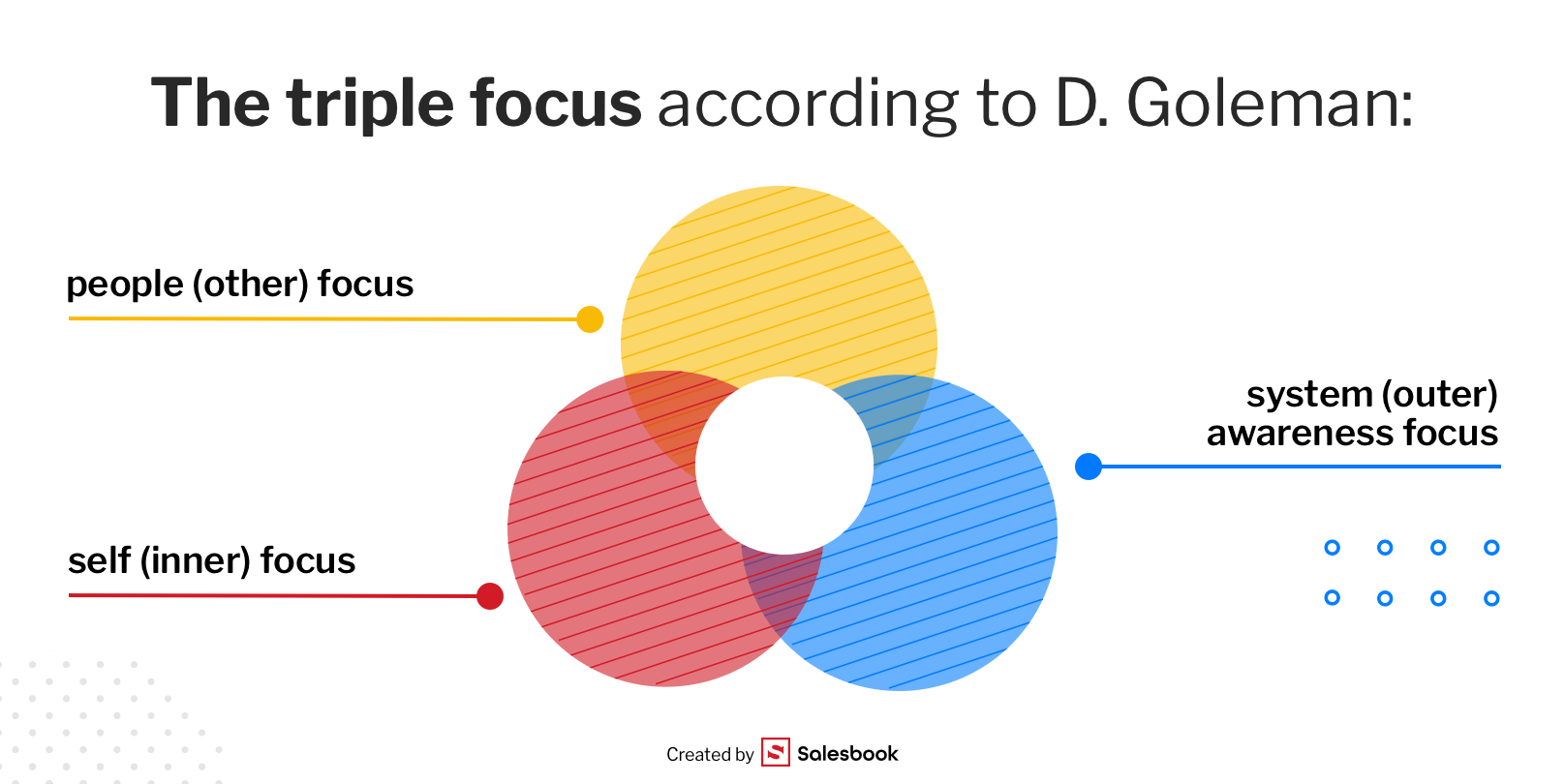
According to Daniel Goleman, a well-known American social psychologist, it is only by knowing and being aware of the three key areas that a leader makes decisions that are good for the organization, and thus provides professional feedback.
The three types of focus and empathy that support good feedback:
1. focus on oneself, one’s own IAM, which consists of:
- the ability to monitor one’s own thoughts, feelings and impulses,
- the ability to remain calm when experiencing stress,
- the ability to focus on the goal and work to achieve intentions,
2. focus on others:
- empathy toward others: empathizing with and understanding how a person thinks, what we can do for that person at a given time,
3. system focus/awareness:
- a systemic understanding, from the perspective of the economics, economy and technology of a particular business.
According to Grzegorz Radlowski in his book “How to Use Feedback. The Art of Feedback,” a good leader should develop all three areas within himself, but it is the second area that may be crucial for him:
“Awareness of the diversity of people, the subtle differences between them, and the ability to recognize them is one of the main competencies in this area.
Particularly important for a leader’s personal development is the second type of focus, where building relationships based on openness, including in difficult moments, and seeing mature responses in different situations from our colleagues, should encourage us to ask for feedback.”
Feedback methods, or how to give feedback
You already know what modern feedback is and that it is worth focusing on building relationships with employees. But how, in practice, should feedback and accompanying messages of various kinds, which are not always pleasing to the ear of the interlocutor, be given?
Read about the sandwich method, FUKO and Stop/Start/Continue. Keep in mind that each of these should be based on good intentions, a positive attitude and talking in private at the right time, without rushing.
Feedback should not be presented in the hallway, instead it should preferably be presented directly and in the office. How the news is conveyed is of great importance.
The sandwich method
Imagine making a sandwich for the recipient before you proceed to give feedback to the employee. What exactly does this look like? You give the less pleasant information between the good news.
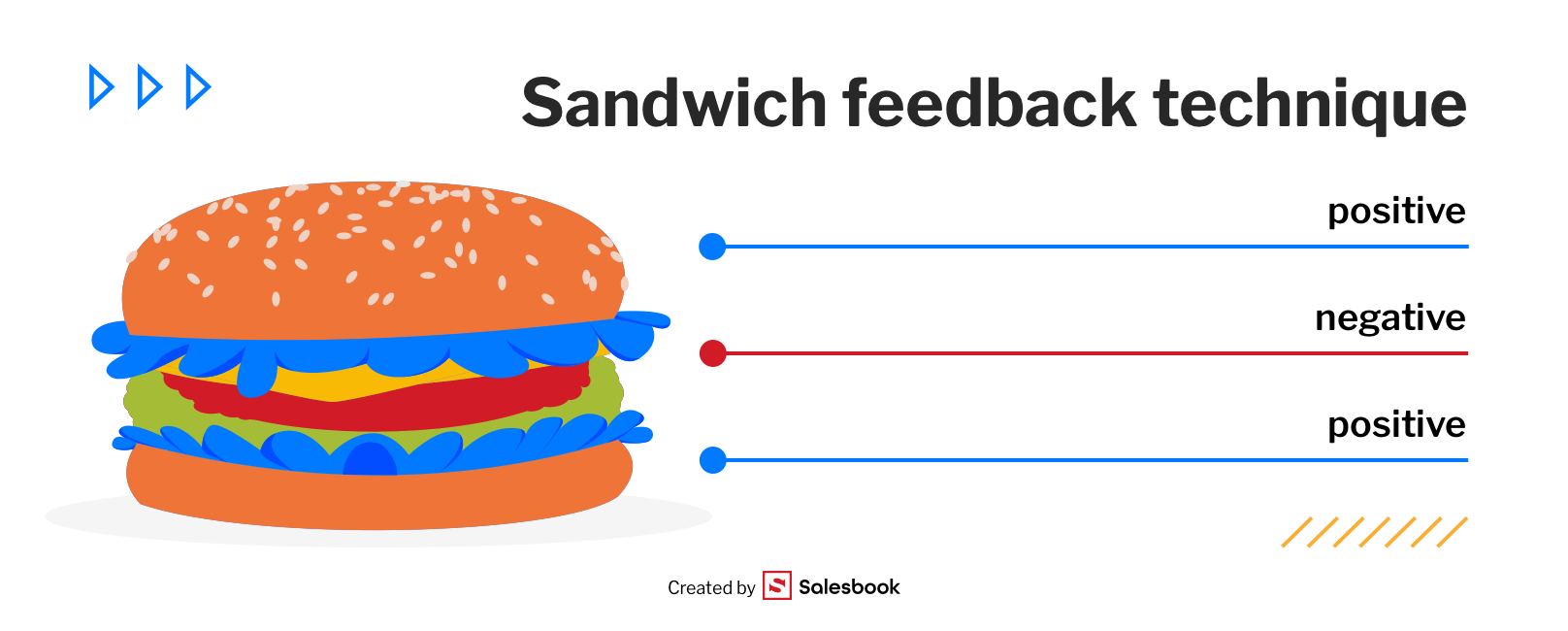
Such feedback transmission looks like the following: positive message – negative message – positive message.
According to HR specialists, the sandwich is useful when giving feedback on a daily basis, when giving tips or commenting on individual tasks.
The disadvantage of this feedback sandwich method when giving feedback may be that the last positive message consisting of nice words will “dilute” what you really wanted to convey.
The FECE method
Another method that will help you give feedback is FECE. It can motivate, but it also somehow prompts salespeople to change behaviors that need improvement.
FECE is an acronym for four words:
- Facts – your message must be based on facts. This is especially important when it comes to negative type and the sales department, for example, because the work of salespeople is a lot of details: frequent meetings with the customer, effective calls, conversations, completed deals. Related to this are key performance indicators and reports, for example, on the number of customers or the value of sales. Your employee’s motivation depends on what and how you communicate.
- Emotions or Relevance – at this stage you describe your emotions and feelings that have been triggered by the facts already cited.
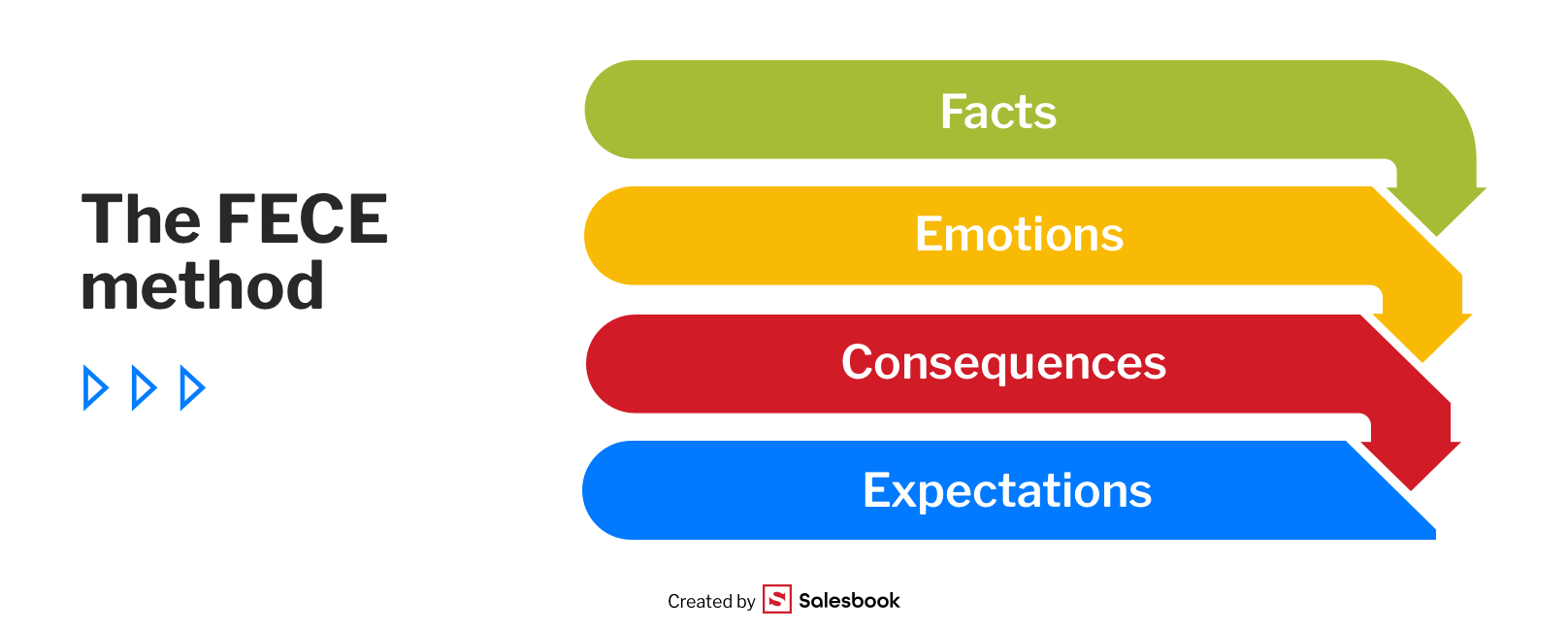
- Consequences – you show the consequences associated with the facts and actions you presented. You do this after identifying the behavior that triggered your feelings. You talk about what will happen if the employee’s conduct/behavior does not change.
- Expectations – you present your expectations to the recipient of the message, identify the implementation of changes and set a goal that you care about achieving.
The disadvantage of this method can be that it requires a lot of commitment from both the team manager and the salesman. If you don’t have time to go through it quite meticulously, you won’t have much success giving feedback.
The SSC method (Stop/Start/Continue)
This is the simplest method with which to give feedback. It won’t work for a very complicated conversation, but it is ideal for everyday communication. It focuses on what should be done, what is completed, and what needs to be continued.

The message is based on three elements:
- Start – what the person should start doing in order to achieve a better result,
- Stop – what the employee should stop doing because it is not having the desired effect,
- Continue – what the salesperson should continue to do because it has a good effect.
This is a method that is useful for conveying simple messages and communications. It does not take into account all aspects of the work.
Feedback that employees want
Feedback for employees in the sales department, but also any other department, is really important. What matters is not only how you give feedback, but also what your message contains.
According to the Labor Market Monitor 35th survey, feedback is most often given in the form of praise or criticism of a completed task (55% of respondents).
Only 38% percent of employees receive a thorough analysis of various aspects of work, such as quality or performance. In contrast, 35% of employees get advice and guidance from their supervisor on what they could do better.
Can you learn how to give feedback? Find out how to do it in practice.
How to give feedback in practice?
So how to avoid mistakes? Use the following advice if you are faced with giving feedback.
- If you have to give it, prepare well. Develop a scenario for the conversation, read the necessary reports, draw conclusions, analyze the data. Support yourself with facts. Your behavior will have a huge impact on the reception of your message. Remember that feedback should not be given under stress and when you are tired(tired).
- Prepare the salesperson for when you are about to give feedback. Arrange a meeting in private at the office. Giving feedback in front of random people will make the vendor lose confidence in you.
- Remember the CEDAR model, which is an expansion of the acronym from the words in English.

- Context (context) – describe the context to which you are referring your message,
- Examples (examples) – give specific examples of behavior, figures,
- Diagnosis (diagnosis) – make an analysis, referring to the examples given,
- Actions – give hints, suggestions, improvements that can improve work results,
- Review (Evaluation) – set further meetings to discuss progress together.
- Refer to specifics: meetings, emails, follow-ups, transactions.
- Explain the impact of the salesperson’s past performance on sales. Use reports. Show specifically what has resulted from what.
- Formulate your expectations clearly. Nothing is worse than convoluted messages and vague goals. Provide specific KPIs.
- Be a partner in the conversation. Address the interviewee directly, maintain eye contact. Listen actively and be open(ed) to the other party’s arguments when explaining mistakes made. Evaluate work behavior, but not a particular person.
- Feedback is not pointing out mistakes. Think of it as a process. Feedback should be part of the company culture. Appreciate that well-provided feedback motivates employees and allows them to grow, which is not without its impact on sales growth.

How can Salesbook help you give feedback?
You already have the knowledge of how to give constructive feedback while not demotivating employees. What you will find useful to supplement your feedback is a modern platform that supports both managers and salespeople, which will provide you with hard analytical data.
Salesbook is a tool that will support you as a manager, as it will gather all the hard quantitative and qualitative data on the performance of salespeople in your department.
With such information, it will definitely be easier for you to give feedback, as it will be backed up with concrete numbers.
Regardless of which method you choose, Salesbook will provide you with arguments you can use in a meeting with a salesman. All you have to do is generate an automated report beforehand.
In the sales department, facts count
With Salesbook, you can analyze the performance of your sales department from many angles. Using the Reports tab in the CRM system, you are able to generate automatic reports on facts that interest you, such as:
- the number of meetings in the calendar by individual salespeople,
- number of meetings at a given time,
- number of phone calls made,
- number of successful offers,
- the value of contracts by salesperson,
- degree of achievement of key performance indicators.
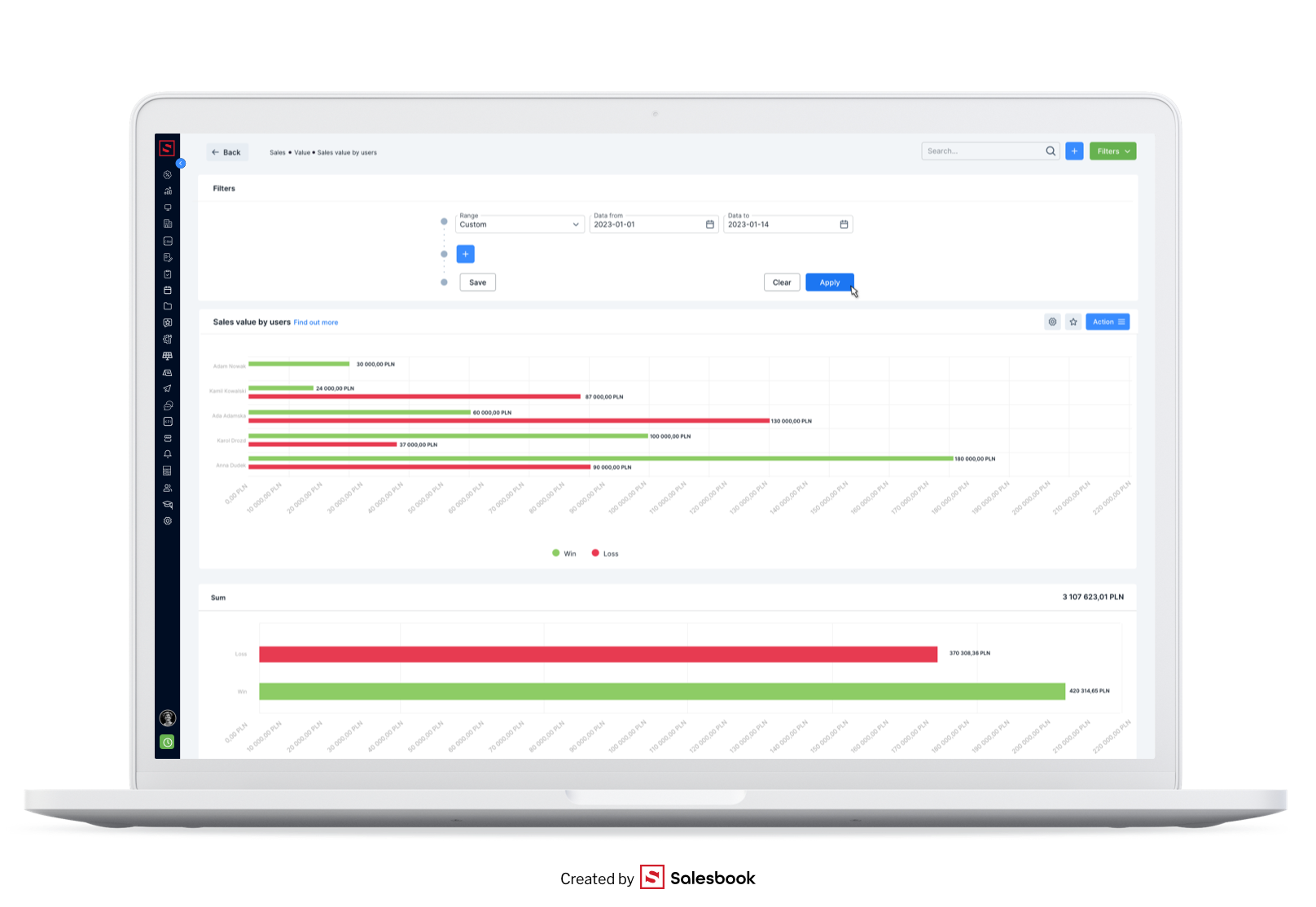
This is just an example of the data you are able to obtain. Salesbook offers you predefined reports on, for example, meetings, customers, salesmen’s work prepared offers or sales forecasts.
At the same time, you can easily (based on the data collected by the CRM system) generate your own report and then add it to the Favorites tab.
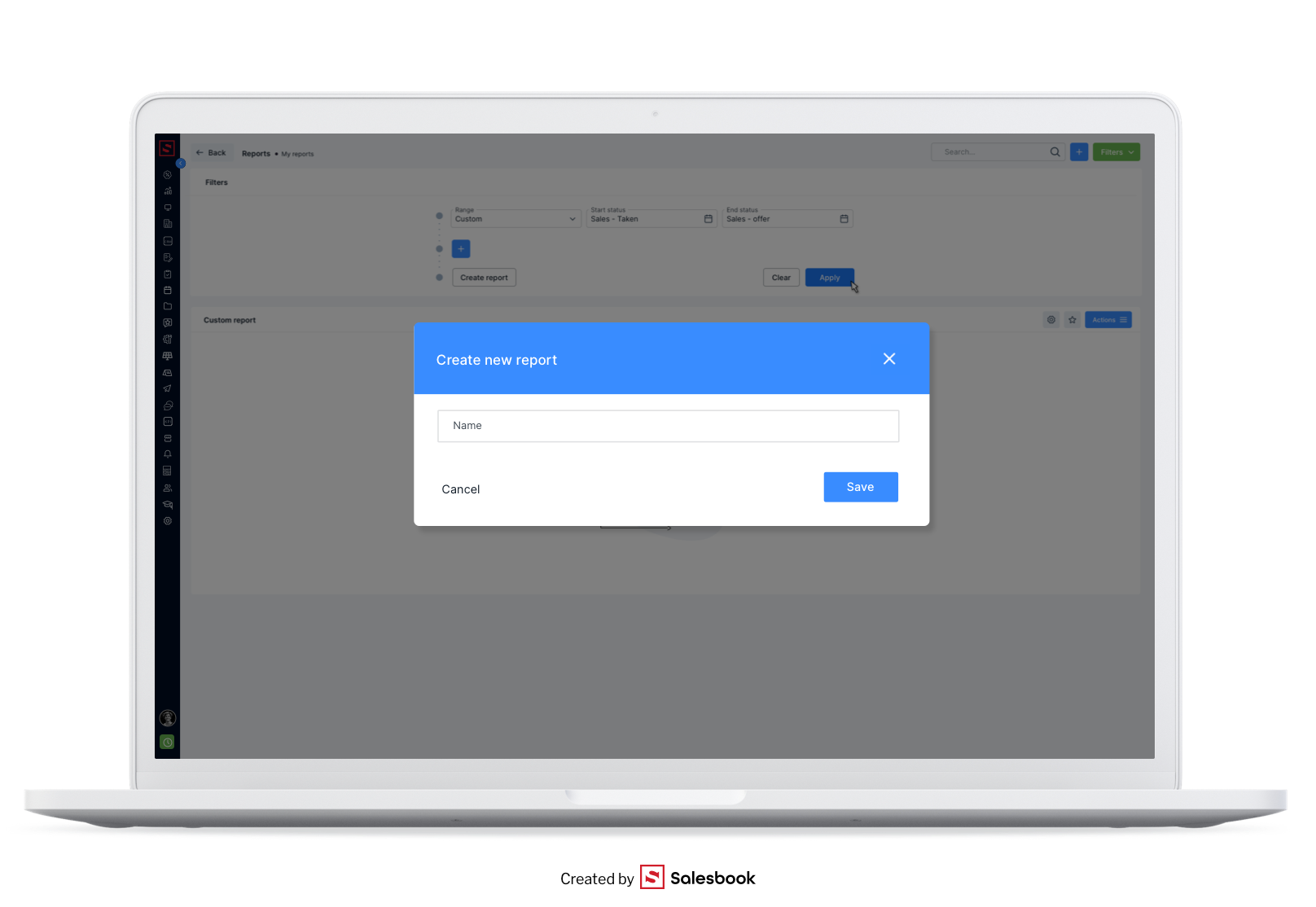
Find out how salespeople work
Quantitative data is only one side of the coin. If you want to give professional feedback, use Salesbook to analyze qualitative data as well.
What can you find out?
- How much time a particular salesperson spent with a particular customer,
- What materials he used during the presentation,
- What steps he performed and which ones are most effective,
- Whether he performs follow-ups in his daily work and how often he does it,
- What communication language he uses, whether he is an expert and can give reliable information about the product.
This is just some of the information you can get from automated reports. If you are interested in this topic, take a look at our blog to learn more about how to measure sales effectiveness.
Summary
Every entrepreneur needs to monitor the work of employees in some way in order to react when its quality starts to deviate from accepted standards.
Giving constructive feedback is much easier and more professional when, as a manager, you can use solid numbers in the form of arguments. Salesbook is a modern tool that takes the responsibility of analyzing them yourself off your shoulders.
See what Salesbook can do for you
If you want to see how Salesbook can support you in your work, schedule a free demo.
Table of Contents







